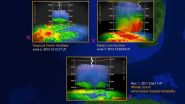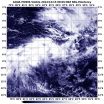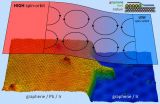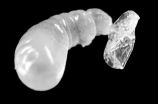(Press-News.org) Each day, thunderstorms around the world produce about a thousand quick bursts of gamma rays, some of the highest-energy light naturally found on Earth. By merging records of events seen by NASA's Fermi Gamma-ray Space Telescope with data from ground-based radar and lightning detectors, scientists have completed the most detailed analysis to date of the types of thunderstorms involved.
"Remarkably, we have found that any thunderstorm can produce gamma rays, even those that appear to be so weak a meteorologist wouldn't look twice at them," said Themis Chronis, who led the research at the University of Alabama in Huntsville (UAH).
The outbursts, called terrestrial gamma-ray flashes (TGFs), were discovered in 1992 by NASA's Compton Gamma-Ray Observatory, which operated until 2000. TGFs occur unpredictably and fleetingly, with durations less than a thousandth of a second, and remain poorly understood.
In late 2012, Fermi scientists employed new techniques that effectively upgraded the satellite's Gamma-ray Burst Monitor (GBM), making it 10 times more sensitive to TGFs and allowing it to record weak events that were overlooked before.
"As a result of our enhanced discovery rate, we were able to show that most TGFs also generate strong bursts of radio waves like those produced by lightning," said Michael Briggs, assistant director of the Center for Space Plasma and Aeronomic Research at UAH and a member of the GBM team.
Previously, TGF positions could be roughly estimated based on Fermi's location at the time of the event. The GBM can detect flashes within about 500 miles (800 kilometers), but this is too imprecise to definitively associate a TGF with a specific storm.
Ground-based lightning networks use radio data to pin down strike locations. The discovery of similar signals from TGFs meant that scientists could use the networks to determine which storms produce gamma-ray flashes, opening the door to a deeper understanding of the meteorology powering these extreme events.
Chronis, Briggs and their colleagues sifted through 2,279 TGFs detected by Fermi's GBM to derive a sample of nearly 900 events accurately located by the Total Lightning Network operated by Earth Networks in Germantown, Maryland, and the World Wide Lightning Location Network, a research collaboration run by the University of Washington in Seattle. These systems can pinpoint the location of lightning discharges -- and the corresponding signals from TGFs -- to within 6 miles (10 km) anywhere on the globe.
From this group, the team identified 24 TGFs that occurred within areas covered by Next Generation Weather Radar (NEXRAD) sites in Florida, Louisiana, Texas, Puerto Rico and Guam. For eight of these storms, the researchers obtained additional information about atmospheric conditions through sensor data collected by the Department of Atmospheric Science at the University of Wyoming in Laramie.
"All told, this study is our best look yet at TGF-producing storms, and it shows convincingly that storm intensity is not the key," said Chronis, who will present the findings Wed., Dec. 17, in an invited talk at the American Geophysical Union meeting in San Francisco. A paper describing the research has been submitted to the Bulletin of the American Meteorological Society.
Scientists suspect that TGFs arise from strong electric fields near the tops of thunderstorms. Updrafts and downdrafts within the storms force rain, snow and ice to collide and acquire electrical charge. Usually, positive charge accumulates in the upper part of the storm and negative charge accumulates below. When the storm's electrical field becomes so strong it breaks down the insulating properties of air, a lightning discharge occurs.
Under the right conditions, the upper part of an intracloud lightning bolt disrupts the storm's electric field in such a way that an avalanche of electrons surges upward at high speed. When these fast-moving electrons are deflected by air molecules, they emit gamma rays and create a TGF.
About 75 percent of lightning stays within the storm, and about 2,000 of these intracloud discharges occur for each TGF Fermi detects.
The new study confirms previous findings indicating that TGFs tend to occur near the highest parts of a thunderstorm, between about 7 and 9 miles (11 to 14 kilometers) high. "We suspect this isn't the full story," explained Briggs. "Lightning often occurs at lower altitudes and TGFs probably do too, but traveling the greater depth of air weakens the gamma rays so much the GBM can't detect them."
Based on current Fermi statistics, scientists estimate that some 1,100 TGFs occur each day, but the number may be much higher if low-altitude flashes are being missed.
While it is too early to draw conclusions, Chronis notes, there are a few hints that gamma-ray flashes may prefer storm areas where updrafts have weakened and the aging storm has become less organized. "Part of our ongoing research is to track these storms with NEXRAD radar to determine if we can relate TGFs to the thunderstorm life cycle," he said.
INFORMATION:
WASHINGTON, Dec. 15, 2014 -- It's something your mother told you time and time again at the dinner table: "Eat your carrots, they'll help you see better!" So was she right? This week, Reactions answers the question with the help of chemist Chad Jones, Ph.D., host of the award-winning Collapsed Wave Function podcast. Check out the video here: https://www.youtube.com/watch?v=w3DNScZYvYY.
Subscribe to the series at Reactions YouTube, and follow us on Twitter @ACSreactions to be the first to see our latest videos.
INFORMATION:The American Chemical Society is a nonprofit ...
Online content creation has become easier than ever and is quickly reaching parity with content consumption. From writing a blog or social media post to letting an app turn your photos into a video montage, anyone with an Internet connection can publish these creations with the click of a button.
But in the age of Web publishing, it has become increasingly confusing for content creators to figure out how to protect their original works or to use other content legally -- such as for remixes or parodies -- on major websites for user-generated content, including YouTube ...
New York (15 December 2014)--A study published today is the first detailed assessment of whether the 8-year Iraq War had an effect on childbearing. The study found that before the war, from 1997 to 2003, adolescent fertility in Iraq was stable at just below 70 births per 1,000 girls aged 15-19. However, soon after the beginning of the war, adolescent fertility rose by more than 30 percent, reaching over 95 births per 1,000 girls in 2010. The study is included in the December 2014 issue of Population and Development Review, a peer-reviewed journal published by the Population ...
Tropical Cyclone Bakung ran into adverse conditions in the Southern Indian Ocean that weakened it to a remnant low pressure system when NASA's Aqua satellite spotted it on Dec. 15.
The Moderate Resolution Imaging Spectroradiometer or MODIS instrument that flies aboard Aqua captured a visible picture of Bakung's elongated remnants on Dec. 5 at 08:05 UTC (3:05 a.m. EST). The storm appeared to be stretched out from west to east in the visible image.
The last advisory on the tropical cyclone came on Dec. 13 when the storm was still a tropical storm with maximum sustained ...
WASHINGTON (Dec. 15, 2014)--Over prescription of antibiotics is a major factor driving one of the biggest public health concerns today: antibiotic resistance. In a first-of-its-kind study, research led by the George Washington University suggests that public health educational materials may not address the misconceptions that shape why patients expect antibiotics, driving doctors to prescribe them more. The research appeared in October in the journal Medical Decision Making.
Researchers from George Washington, Cornell and Johns Hopkins universities surveyed 113 patients ...
Researchers in Spain have discovered that if lead atoms are intercalated on a graphene sheet, a powerful magnetic field is generated by the interaction of the electrons' spin with their orbital movement. This property could have implications in spintronics, an emerging technology promoted by the European Union to create advanced computational systems.
Graphene is considered the material of the future due to its extraordinary optical and electronic mechanical properties, especially because it conducts electrons very quickly. However, it does not have magnetic properties, ...
To the casual observer, the colonies of social insects like bees and ants appear to be harmonious societies where individuals work together for the common good. But appearances can be deceiving.
In fact, individuals within nests compete over crucial determinants of fitness such as reproductive dominance and production of male eggs. The intensity of competition often depends on the level of kinship between colony members. This is because selfish individuals lose indirect fitness when their behavior harms close relatives. A new study by Eva Schultner and colleagues from ...
Just in time for Christmas, Simon Fraser University computing science professor Richard Zhang reveals how to print a 3D Christmas tree efficiently and with zero material waste, using the world's first algorithm for automatically decomposing a 3D object into what are called pyramidal parts.
A pyramidal part has a flat base with the remainder of the shape forming upwards over the base with no overhangs, much like a pyramid. A pyramidal shape is optimal for 3D printing because it incurs no material waste and saves print time.
The algorithm promises to become a big deal in ...
DALLAS - Dec. 15, 2014 - UT Southwestern Medical Center researchers have identified a possible therapy to treat neurofibromatosis type 1 or NF1, a childhood neurological disease characterized by learning deficits and autism that is caused by inherited mutations in the gene encoding a protein called neurofibromin.
Researchers initially determined that loss of neurofibromin in mice affects the development of the part of the brain called the cerebellum, which is responsible for balance, speech, memory, and learning.
The research team, led by Dr. Luis F. Parada, Chairman ...
Irvine, Calif., Dec. 15, 2014 - Dangerously high levels of air pollutants are being released in Mecca during the hajj, the annual holy pilgrimage in which millions of Muslims on foot and in vehicles converge on the Saudi Arabian city, according to findings reported today at the American Geophysical Union meeting in San Francisco.
"Hajj is like nothing else on the planet. You have 3 to 4 million people - a whole good-sized city - coming into an already existing city," said Isobel Simpson, a UC Irvine research chemist in the Nobel Prize-winning Rowland-Blake atmospheric ...






